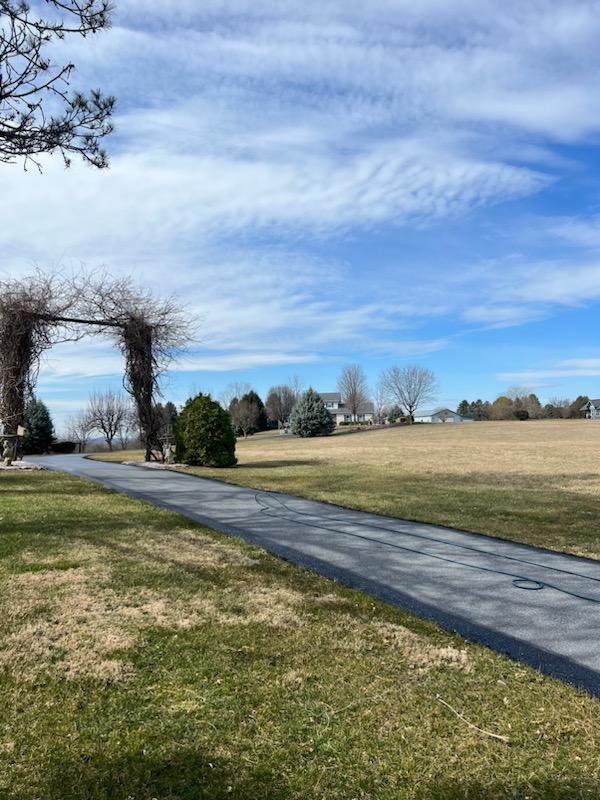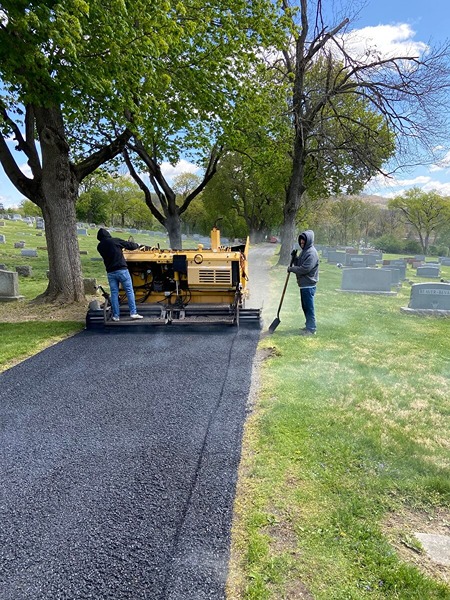How To Seal Coat A Driveway: A Step-By-Step Guide
Asphalt driveways are an attractive and cost effective way to enhance the appearance of any property.
To maintain their aesthetic appeal, asphalt driveways should be seal-coated every two to four years.
Seal-coating is a simple process that can be easily completed by a home owner or asphalt paving contractor.
This article will provide a step-by-step guide to effectively seal coat an asphalt driveway.
It will outline all the necessary materials and equipment as well as describe the application procedure.
Following these steps will ensure a successful seal coating job and extend the life of the driveway.

Gather Necessary Materials And Tools
Asphalt paving contractors often face the challenge of how to seal coat a driveway. To achieve a successful outcome, it is necessary to gather the right materials and tools.
These include asphalt emulsion, squeegee or sprayer, broom, spreader box, and a power roller.
An anecdote that illustrates this process is that of an experienced contractor who had been in the business for many years. His goal was to apply a new coating to his client’s driveway without any issues. After gathering all the necessary materials and tools, he was able to successfully complete the job quickly and efficiently.
The importance of having the right materials and tools cannot be understated when it comes to sealing a driveway. It makes the job much easier for asphalt paving contractors and helps ensure that jobs are completed successfully in a timely manner.
As such, it is essential for contractors to make sure they have everything they need before starting any project involving asphalt pavements. With all the required items on hand, contractors can move on with confidence to cleaning and preparing the driveway for sealcoating.
Clean And Prepare The Driveway
Before applying primer and sealer, the driveway must be thoroughly cleaned and prepped.
The first step is to sweep off all debris, such as dirt, leaves, and stones, from the surface of the asphalt.
Then it’s important to use a pressure washer to remove oil stains, grass clippings, or other substances that could interfere with the adhesion of the sealer.
It is also necessary to fill any cracks or potholes on the surface of the asphalt with a patching compound. This will prevent water from seeping under the sealer and causing damage in the future.
After filling in any cracks or potholes, it is important to allow enough time for them to properly dry before proceeding with any further steps.
With these preparations complete, it is now time to move onto applying primer and sealer.
Transitioning into this step requires an understanding of how materials interact with one another and their overall compatibility for optimal results.
Apply Primer And Sealer
Sealing a driveway requires careful preparation and planning. Before you begin, make sure that the surface is clean and dry.
To prepare for the next step, now it’s time to lay the groundwork: applying primer and sealer. This process is like laying the foundation of a house; it must be done correctly in order to ensure a successful result.
The first step is to apply an asphalt emulsion primer with a squeegee or broom. This will help promote adhesion between the pavement and sealant. Be sure to evenly coat the entire surface area with primer, taking care not to skip any spots or leave clumps behind. Allow this layer of primer to dry completely before moving on to the sealer application process.
When applying sealer, use an asphalt squeegee or spray machine for optimal results. Start from one end of your driveway and work your way towards the other side in straight lines, taking care not to overlap any areas. If using a spray machine, keep in mind that three thin coats are better than one heavy coat when it comes to ensuring proper coverage and protection.
Once finished, allow adequate time for the sealer to dry before proceeding with gravel and sand spreading steps.
Spread Gravel And Sand
1.Prior to starting a driveway sealcoat project, it is important to prepare the area by removing any existing debris and ensuring the surface is free from dirt, dust and vegetation.
2.Once the area is prepped, the next step is to spread the gravel evenly across the surface. The gravel should be spread in an even layer that is 1-2 inches thick, and the surface should be lightly compacted before the sand is applied.
3.The final step of the process is to spread the sand evenly across the gravel and lightly compact the surface again to ensure the sealcoat will adhere properly.

Prepare Area
Prior to starting the gravel and sand application process, it is essential to adequately prepare the driveway surface.
The area should be cleared of debris, large stones, and any vegetation that needs to be removed.
A broom or leaf blower can be used to clear away dirt and other debris from the area.
The surface should then be cleaned with a pressure washer and a cleaning solution with a pH level between 8-10 so that it is free of oil and grease stains.
If there are any existing cracks in the driveway, they should be filled with an asphalt patching compound prior to applying gravel and sand.
Finally, a primer should be applied to the surface before gravel and sand are added in order for them to adhere properly.
Apply Gravel And Sand
Once the driveway surface has been adequately prepared, it is time to apply gravel and sand.
The first step is to spread a layer of gravel over the entire area, making sure to fill in any low spots or depressions that may have been created when the surface was leveled.
The gravel should be spread evenly and tamped down with a roller to ensure that it is firmly compacted.
Once the gravel has been compacted, a layer of sand should then be spread over the entire surface.
This layer of sand should also be tamped down with a roller to ensure that it is properly compacted.
Finally, once both layers are firmly in place, they can be brushed and raked into an even and level surface ready for use.
Final Touches And Clean Up
After the sealcoat has had sufficient time to dry, it’s important to note that the driveway should be avoided for 24-hours. This is to ensure that traffic on the driveway does not disrupt the newly applied sealcoat.
During this waiting period, you should also:
As an asphalt paving contractor, it is essential that all of these steps are taken to ensure a successful sealcoating job. If done correctly and with care, your driveway will last longer and look better than ever before.
To finish off the job correctly, you have one final task: clean up! All tools, equipment and materials must be removed from site and stored properly for future use. It is important to dispose of any leftover material responsibly by adhering to your local waste disposal regulations.
Attention to detail at this stage will provide a much smoother experience when it comes time for another job down the line.
Conclusion
The process of seal coating a driveway is an essential part of preserving and protecting asphalt. Even with proper maintenance, asphalt driveways will eventually begin to deteriorate due to exposure to the elements. Seal coating provides an effective barrier against weathering and other damage, extending the life of the driveway.
By following this step-by-step guide, you can easily seal coat your driveway and enjoy years of protection.
It is important to be aware that seal coating should not be considered a permanent solution as it requires regular maintenance and reapplication in order to ensure optimal coverage. However, if done correctly, you can expect years of reliable performance from your newly sealed driveway.
Despite the effort involved, the results are well worth it for those looking for long-term protection from the elements.
What Type Of Asphalt Should I Use For My Project?
Asphalt paving contractors can provide insight on which type will best suit your needs.
From porous asphalt that is incredibly durable and eco-friendly to an impressive range of traditional and advanced asphalt mixes, there are endless possibilities – each offering its own unique advantages.
Whether you are looking for a formidable solution that is sure to stand the test of time or an option with spectacular aesthetic appeal, you can rest assured that investing in quality asphalt will be worth every penny.
What Is The Typical Timeline For An Asphalt Paving Project?
The process involves preparing the surface by removing existing material, grading and compacting the area, and then laying down asphalt.
After the asphalt is spread, it must be rolled for proper compaction.
Any additional steps such as marking or adding curbs may require more time.
In addition, weather conditions can affect timelines as well.
It is important to work with a quality asphalt contractor who has experience in completing projects on time and on budget.
How Often Should I Seal Coat My Driveway?
Most professionals recommend sealcoating your paved surface every two to three years, depending on the climate and amount of traffic it gets.
In general, climates with high temperatures and direct sunlight require sealing more frequently, while cooler climates need less frequent sealing.
Additionally, driveways that see heavy or frequent use will require more frequent sealcoating than those that are rarely used or parked on.
Are There Any Special Considerations For Commercial Or Industrial Paving Projects?
First, the area must be properly assessed in order to determine if a thicker asphalt layer is needed to support heavier vehicular traffic and increased weight load.
Additionally, a professional contractor should be consulted in order to ensure proper drainage and longevity of the pavement.
Furthermore, the contractor should have experience in the specific type of surface being paved such as parking lots, driveways or roads.
Finally, an experienced contractor will also evaluate the existing surface for any potential issues that could affect the final outcome of the project.
How Much Sealant Will I Need To Cover My Driveway?
Depending on the size and condition of the asphalt surface, this amount can vary greatly.
If there are cracks present, it is advisable to fill them before applying the seal coat.
Additionally, a thicker application may be necessary for surfaces that have not been sealed in many years or have significant wear and tear damage.
For optimal coverage and protection it is recommended to purchase slightly more than estimated to ensure the entire area is properly sealed.